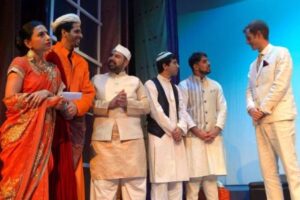By E.M. Forster, adapted by Martin Sherman. Director: Mark G. Nagle. Genesian Theatre, Sydney. 15 May – 19 June, 2021.
Reviewed : 15 May, 2021

British writer E.M.Forster travelled extensively in India between 1912 and 1913, and returned there for a short time as a public servant in 1921. His novel A Passage to India, based on the political, social and spiritual divisions he observed during his visits, was first published in 1924. Set in a fictitious Indian city called Chandrapore, it was originally adapted as a play in 1960 by Santha Rama Rau. The 1984 screenplay, written and directed by David Lean, starred Judy Davis in the leading role of Adela Quested, while Dame Peggy Ashcroft won the Academy Award for best supporting actor in the role of Mrs Moore.
Martin Sherman’s 2002 adaptation is true to Foster’s intricate plot, his portrayal of the British Raj and the characters he created. A cast of twenty British and Indian characters tell the story of Miss Adela Quested’s desire to see the real India and meet real Indian people. The complications that follow include a strange ‘bridging the social gap’ party, a trip to a system of unsupervised caves, a false accusation, a wrongful arrest, and a trial that accentuates the racial tensions and prejudices inculcated by the Raj.
It is almost an epic. There are so many scenes, so many characters, so many directorial and organisational challenges! Depicting the time and place authentically. Finding just the right cast. Choreographing twenty actors in an early 20th century Indian street scene. Creating a dark claustrophobic cave with an insistent, eerie echo.
Mark G. Nagle is to be commended for having the courage to take on those challenges. He and his creatives – costume designer Andrea Tan, lighting designers Sarah Gooda and Michael Schell, sound designers James Julian Wilson and Vishal Shah, choreographer Akshat Gupta – have recreated a little bit of India in summer in the early 1900s. They have also used imaginative ideas to depict some tricky scenes.
The overall tenor of the play is set by an opening tableau. There is a huge Union Jack. The cast is arranged, as if for a photograph, in racially distinct order. From a photograph above them, King George V looks benignly over one of the ‘jewels’ in his Empire and the rousing, imperial words of “Land of Hope and Glory” sound righteously above them.
Gaurav Kharbanda as Professor Narayan Godbole then assumes the role of narrator, pundit and would-be comedian. Kharbanda carries this role effectively. He is both funny and engaging, and links the facets of the story effectively.
On the set, colourful hangings break the harsh light of summer heat and the climate-sensible fashions of the Indian fashions accentuate the unsuitable stuffiness of the British uniforms. The costumes have been carefully sourced and add to the authenticity of the period. Miss Quested (Christine New) looks beguiling in cream silks and lace.

Some of the difficult scenes are handled inventively. With the help of several cast members, the enormous, heavy duty Union Jack becomes a swaying elephant, then is ‘vacated’ to lie on the floor as a (potentially dangerous) floor covering.
The claustrophobia of a dark, threatening cave is achieved by a low canopy of interlocking rods held by cast members above the head of Mrs Moore (Susan Jordan). Dark lighting and a constant echo add to the menacing scene. A similar echo frightens Miss Quested as she ventures into another cave.
The court scenes, too, are effective. While Dr Aziz (Atharv Kolhatar), accused of ‘interfering with Miss Quested in the cave, stands in a dock made of bamboo rods, the judge and notaries stand on levels above the body of the court.
Nagle’s direction, too, takes into consideration the differences in customs and culture. The British characters stand and sit aloof. Their speech is stilted (their accents just a little too contrived) and they treat the Indian characters with disdain. Away from that contempt, the Indian characters are relaxed and cheerful.
The many scene changes – and establishing the complications of inter-locking events and relationships – make this a long production. The choreography of the scene changes will become smoother as the run proceeds, and this will improve the pace of a production that is, perforce, multifaceted.
The cast plays 39 characters – and an elephant! And carries out most of the many scene changes. They bring theatre and music experience from India, Singapore, New Zealand and the United Kingdom to the Genesian stage. It is great to see such a diverse and multi-talented cast in such a testing production.
Congratulations to Mark G. Nagle and his team for bringing his ambitious vision to the stage.
First published in Stage Whispers magazine